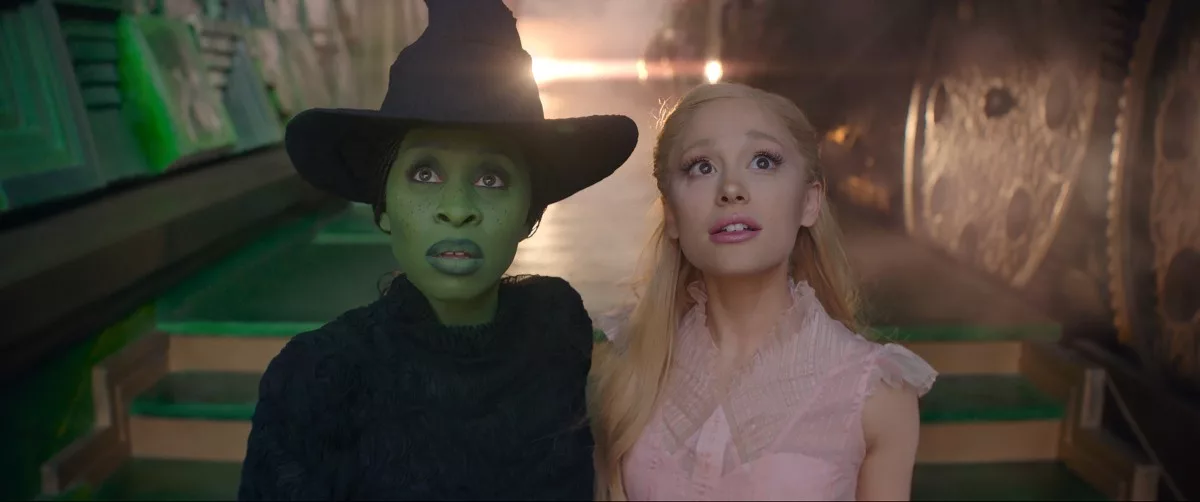Movie Reviews
Movie Review – Ferrari

Read Time:2 Minute, 35 Second
Ferrari suffers from trying to tell too many stories. Is it a story about the evolution of a married relationship over time and how they struggle with the recent death of their son? Or is it about the Ferrari company, or racing, or even the relationship between a father and his illegitimate son? As in real life, a lot is going on all at once during this movie, but the movie doesn’t see any of these stories through to their resolution. Everything is left incomplete with no takeaway.
The acting by the main cast was good to very good. Penélope Cruz’s performance is the one that stands out to me, mostly due to having a character with a large emotional palette. Adam Driver was good, and what I noticed most was his mannerisms, as he emulated the late Enzo Ferrari.
—–Content continues below——
There is one particular scene that pissed me off. The car crash, which happened at the 1-hour 48-minute mark, was completely out of pl ace for this movie. It’s like sticking in a horrifying and gruesome scene from a war movie. That’s fine if you’re watching a graphic war movie. That’s what you signed up for. But this movie doesn’t show a drop of blood until that scene and then we are suddenly thrust into seeing… I’m not even going to write what you see. Just don’t look.
Dear, director/editor,
What in the F#$% were you thinking? You released this movie on Christmas Day. People don’t need to see this shit. There’s no upside in showing this. It isn’t going to change any policy or save any lives today because this event happened 60+ years ago. Have some f#$%ing decency and edit this crap out.
Race
Aside from the crash scene, I found the race anticlimactic because it was impossible to figure out which car belonged to which team. There was no suspense, just scenes of cars racing down streets and through cities.
Conclusion
There you go. If you want to see a movie that tells too many stories and doesn’t properly resolve anything, then this is your ticket.
Grade: D
About The Peetimes: I have three Peetimes plus an Alert Peetime near the end. I think the first and third Peetimes are the best. The middle one isn’t bad, but there is more emotion than the others. I personally can’t stress enough to look away during the Alert Peetime. It is only 55 seconds long. No one needs to see this stuff on Christmas Day.
There are no extra scenes during, or after, the end credits of Ferrari.
| Rated: | (R) Sexual Content | Language | Graphic Images | Some Violent Content |
| Genres: | Biography, Drama, History |
| Starring: | Adam Driver, Shailene Woodley, Giuseppe Festinese |
| Director: | Michael Mann |
| Writer(s): | Troy Kennedy Martin, Brock Yates |
| Language: | English |
| Country: | United States, United Kingdom, Italy, China |
Plot
Set in the summer of 1957, with Enzo Ferrari’s auto empire in crisis, the ex-racer turned entrepreneur pushes himself and his drivers to the edge as they launch into the Mille Miglia, a treacherous 1,000-mile race across Italy.
Don’t miss your favorite movie moments because you have to pee or need a snack. Use the RunPee app (Androidor iPhone) when you go to the movies. We have Peetimes for all wide release films every week, including Aquaman and the Lost Kingdom, The Color Purple, Ferrari, Godzilla: Minus One, and coming soon The Beekeeper, I.S.S., Argylle and many others. We have literally thousands of Peetimes—from classic movies through today’s blockbusters. You can also keep up with movie news and reviews on our blog, or by following us on Twitter @RunPee.
If there’s a new film out there, we’ve got your bladder covered.
Creator and developer of the RunPee app. When something doesn’t work right in the app it’s pretty much his fault. 🙂
Aspiring author. Would like to finish his “Zombie Revelations” trilogy if he could break away for working on RunPee and the cottage he’s building for RunPee Mom.
You might also like…

Movie Reviews
Margaret Pomeranz: The 10 films you should watch, but probably haven’t

MP: Well, I don’t think we truly gelled for about five years because I was so nervous, and it took me time to be able to relax in front of camera.
Fitz: So you became an iconic duo, just like Roy and HG. In their case, they never socialised much off-camera so as to keep their on-air stuff fresh. Did you spend much time with David Stratton when the cameras weren’t rolling?
MP: We did, but never excessively, apart from when we went to things like the Cannes and Venice film festivals, when we would certainly see a great deal of one another. Back in Australia, we saw a bit of each other until he moved up to the Blue Mountains, which I was really shitty about, actually …
Fitz: And how do you judge the current state of the movie business globally and in Australia?
MP: Well, I think the Australian film industry is really healthy. It’s almost like it’s got the confidence in itself. Globally, on the one hand, I’m sick of those Marvel Comics being translated to the screen, but on the other hand, you can get really good ones, like the one that Taika Waititi directed, Thor: Ragnarok. That was terrific. So you can’t be narrow-minded about such films. Some are extremely good.
Jeff Bridges in Peter Weir’s brilliant Fearless.Credit: Warner Bros
Fitz: And where are your professional energies going right now?
MP: Nowhere! I am trying to get out of stuff, not into stuff.
Fitz: Two more quick questions, then we can rip in. I read a blurry report that you might have had a cameo role in Priscilla, Queen of the Desert. Is that correct?
MP: Yes, but blink and you’ll miss me, right? I had known the director, Stephan Elliott, for some time, and he said, would I play a part in his film? And I said, “All right, as long as I’m not playing anybody’s mother”. Not long afterwards, I was in Venice at the film festival, and a fax arrived for me, saying he wanted me in Priscilla, indeed playing someone’s mother, but … “You’re playing Guy Pearce’s mother”. So I said, “Oh, all right!”
Fitz: Meantime, I loved your review on Charlie Pickering’s The Weekly on ABC of Married at First Sight where you said, “It’s a groundbreaking social experiment in which mentally fragile halfwits marry toxic fame tarts”. Is there anything you’d like to add to that? Or is that about it?
MP: [Laughs.] No, that’s about it.
Fitz: OK, let’s get to the nub of it. Can you please gimme the 10 films few of us have seen yet, but bloody well should?
Dannielle Hall and Damian Pitt in Beneath Clouds.Credit: © Bunya Productions
MP: Well, my first one is the Australian film Beneath Clouds (2002). That was Ivan Sen’s debut feature about two Indigenous kids, played by Damian Pitt and Dannielle Hall, who accidentally join up as they head for various reasons to Sydney from country NSW. Sen had made a series of really fantastic shorts when he was at the film school, and once he was out he made this. It looks fabulous. It’s heartrendingly great, but very little seen. I’m always moved by the final image in a film, and in this one, it’s just heartbreakingly good. Have you seen it?
Fitz: No, never heard of it, but I will see it soon! Next?
MP: OK, going down the list, I loved Locke (2013) by Stephen Knight. Tom Hardy gives an outstanding performance in this film in which he is the only presence on screen. He plays a man driving to a construction site who takes 38 phone calls from various people as his life falls apart.
Fitz: Hang on, just one actor? So when the screen credits roll for actors, there’s one person?
MP: Yes, apart from voice actors.
Fitz: That sounds like that famous first film by Steven Spielberg, Duel, with the menacing truck being the key presence monstering the poor bloke in front. Go on, next?
MP: Number three is Fearless (1993), by Peter Weir, starring Jeff Bridges and Rosie Perez as survivors of a plane crash who each experience the impact of the aftermath. Have you seen that?

The 1997 film Gattaca imagines a future class divide between the enhanced (as played by Uma Thurman) and the unenhanced.Credit: Getty Images
Fitz: No! Look, if it’s not Shawshank Redemption or the like, you may presume I haven’t seen it, but want to. I want you to educate me and mine on the finer things in films so we can say to our friends, “I can’t believe you haven’t seen those wonderful films, Beneath Clouds, Locke and Fearless! What kind of bogan ignoramus are you?”
MP: [Small groan.] Number four is District 9 (2009). This totally original, low-budget science fiction film from South African writer/director Neill Blomkamp has it all – a wild imagination, drama, pathos, compassion, with a few laughs thrown in, as a man organising the relocation of a camp of segregated aliens becomes one of them.
Fitz: You see, Margaret? Don’t despair, I’ve heard of it!
MP: So is that all right?
Fitz: Yes, please go on.
MP: I’ve chosen Nashville (1975). A gigantic tapestry of music, betrayal and politics set in the country music capital of the world and is the work of director Robert Altman. It has a multi-character cast and was the film that excited me most when I first saw it. It is still my favourite film of all time. I fell in love with Robert Altman when I saw it in Sydney, even though it was on screens for just a week, and it was gone. I dragged people to it, and then it disappeared.
Fitz: If you say it is your favourite of all time, that is some recommendation. Next, please?
MP: Gattaca (1997). This debut science fiction film from New Zealand born writer/director Andrew Niccol explores the ethics of genetic engineering. Niccol wrote The Truman Show, but when he went to Hollywood, they wouldn’t let him direct it and gave him Gattaca to direct instead. It stars Ethan Hawke and Uma Thurman and is riveting.

Lust, Caution, directed by Ang Lee, is set in China during the Japanese occupation. Credit:
Fitz: Not that you care, but I broadly hate sci-fi. Still, I will give it a go.
MP: The Hill (1965) is a gruelling portrayal of men struggling to survive a military prison camp in North Africa during World War II, and it stars Sean Connery in one of his best performances. I don’t like prison movies much, but this one has stayed with me.
Fitz: I like Shawsha … actually, never mind. Does The Hill have a happy ending? You’ll despair to hear, Marge, my tastes are so plebeian: I genuinely like films where the hero and the heroine go through lots of struggles and get to kiss in the final frame – with the exception of Brokeback Mountain, where it was the two heroes.
MP: [Small pause.] I absolutely adored Brokeback Mountain. I saw that in Venice, and when everybody else was rushing off to the next screening, I just stayed sitting there alone, still absorbing it, it was so wonderful. But, moving on. I love tough films. And the one that I love most is The Lives of Others (2006), the debut film from German writer/director Florian Henckel von Donnersmarck about the impact that Stasi agents, East Germany’s secret police, have on a group of artists and intellectuals. A really powerful cinema experience.
Fitz: Next?
MP: Lust, Caution (2007). Ang Lee’s beautiful, emotionally powerful film is set in China during the Japanese occupation. It’s about a young student’s relationship with a high-ranking collaborator despite the fact that she’s part of a group that aims to assassinate him. And the next one after that is a soft one for you, Peter. I’ve chosen Chef (2014), written, directed by and starring Jon Favreau. It’s the story of a celebrity chef in an upmarket restaurant who loses his temper as he’s not prepared to conform. So he starts up a food truck with the help of his son and estranged wife. And you’ll be thrilled to hear, Peter, this one has a happy ending.
Loading
Fitz: Excellent! And that’s our 10. So the last thing is this. We’ve talked about films that you know are great, that should be more widely celebrated. What about films where everybody loves them except you? I hate to say it, but the best example for me is the one you’re in: Priscilla, Queen of the Desert. Yes, all the actors are great, and Hugo’s a personal friend. But I just never understood the level of acclaim it received.
MP: [Laughing.] Of course it was the one I was in! But, yes, I don’t always like what everybody else likes. I don’t necessarily like what David Stratton likes. I actually talked to him this morning about the list I just gave you, and I think he approves of just about all the ones on my list, but not all. Generally, I think that within seconds of a film opening, you know whether you’re in good hands with a director or not, and it’s really weird that some films just scream: “I am no good!” from the very beginning.
Fitz: And the blockbuster that you detest?
MP: A really popular film that everyone else loved was the remake of The Texas Chainsaw Massacre. It’s only one of the two films I’ve ever walked out of.
Fitz: And what is the other, please?
MP: I will tell you, but it’s not for publication. [We go into the Cone of Silence.]
Fitz: Oh! Oh, I see … Thank you, indeed. I, and my readers, shall report back before Chrissie on what we think of your list. In the meantime, we are in your debt. At least we hope so.
Movie Reviews
Movie review: Wicked – Baltimore Magazine

There’s been a curious trend in the promotion of movie musicals lately. The trailers and commercials have obscured the fact that they are musicals. This was true of the Mean Girls trailer, which made the film seem like a highly redundant note-for-note remake of the Lindsay Lohan original. And it was also true of Timothée Chalamet’s Wonka, a particularly baffling choice since the original was itself a musical. Both those films did well at the box office but I would argue this was in spite of, not because of the sneaky marketing strategy.
Musicals are having a moment. It’s an extension of fan culture—that is to say, culture—with musical theater nerds loudly and proudly staking their claim among the other fandoms on social media. When I went to see The Outsiders on Broadway, there was a large group of teenage girls screaming for Ponyboy and cheering in anticipatory excitement before all the big numbers. When I caught a preview of The Great Gatsby, the screams were so loud you would think star Jeremy Jordan was Harry Styles.
Certainly among the most enduringly popular musicals is Wicked, the girl-power reimagining of The Wizard of Oz, which made co-stars Idina Menzel and Kristin Chenoweth stars—or at the very least, god tier among musical theater nerds.
Happily, Universal Pictures didn’t try to obscure the fact that Wicked is a musical, but that’s not to say the production was without controversy. Everyone agreed that Cynthia Erivo, who won the Tony for The Color Purple and was Oscar nominated for her turn as Harriet Tubman in Harriet, was perfect for the part of misunderstood witch Elphaba, but mega pop star Ariana Grande as Glinda? When there were deserving musical theater professionals out there in need of a big break? Additionally, the promotion was not above its own bait and switch. Never seen in the commercials and trailer is the fact that the nearly three hour film is merely part one. Part two is due next year.
Let’s get those “controversies” out of the way first. Ariana Grande is a marvelous Glinda—pampered, entitled, but secretly kind—like Alicia Silverstone in Clueless if she had pipes for days. Anyone who has seen Grande on Saturday Night Live already knew she was funny—and here, her stellar comic timing is aided by her adoring sidekicks played with gleeful “you can’t sit here” bitchiness by Bowen Yang and Bronwyn James. As for the film being a part one? I wouldn’t fret it. It ends perfectly. You feel satisfied with what you just saw, while eagerly anticipating the next installment.
So yeah, Wicked is good. Almost great, although I couldn’t quite warm up to all the CGI sets and backdrops. I understand that director Jon M. Chu worked hard to create a built environment, even going so far as to plant 9 million tulips to recreate Emerald City (reader: I thought they were fake). But, despite his best efforts, the film still has that slightly glossy, uncanny feeling of AI. Give me cheesy, hand-built sets any day.
Still there’s a lot to recommend here, as the film is filled with wit and cleverness and verve. Erivo, as expected, makes for a heartbreakingly vulnerable, yet fierce Elphaba, and her belting out of “Defying Gravity” feels like cinematic catharsis at its finest. There are also excellent supporting turns, including Jonathan Bailey as the dashing but romantically conflicted Fiyero; Michelle Yeoh as the glamorous professor of the dark arts, Madame Morrible; the voice of Peter Dinklage as the wise and kindly goat professor, Dr. Dillamond; and Jeff Goldblum as the Wizard. (I mean, of course, Jeff Goldblum is the Wizard of Oz. It’s casting as inevitable as it is perfect.) Also, look out for a few smartly placed cameos. (Can you say: Adele Dazeem?)
Directed and performed with flair and obvious affection for the source material, Wicked is a wickedly good time at the movies. And yes, I imagine it’s going to be popular, as I’m already thinking of shelling out 15 bucks to see it again.
Movie Reviews
Superb reviews and a good opening for Nazriya’s Malayalam comeback film | Latest Telugu cinema news | Movie reviews | OTT Updates, OTT

Suspense thriller Sookshmadarshini marks Nazriya’s return to Mollywood after a hiatus of four long years. Directed by MC Jithin and starring Basil Joseph as the male protagonist, the movie hit the big screens yesterday. Sookshmadarshini received glorious reviews from critics and is off to a good start at the box office.
In Kerala this Nazriya Nazim starrer collected in the vicinity of Rs. 1.6 crores gross, which can be termed as a promising start. The occupancies picked up in the evening and night shows once the reports started coming in. Even though the film had a limited release in the USA, it raked in over $30K on the opening day. The showcasing is expected to increase in this territory from today. Globally, the movie earned approximately Rs. 4 crores gross.
Riding on the terrific word of mouth, Sookshmardarshini commenced its day two with a bang. The movie is now selling around 7K tickets per hour on the BMS portal. Said to be made on a shoestring budget, the film has a high chance of emerging as a blockbuster. Sooskhmadarshini will have a solid weekend, but its performance on the first Monday will give us an idea about the final numbers.
Sookshmadarshini is bankrolled by cinematographers Shyju Khalid and Sameer Tahir, along with AV Anoop. The movie also stars Deepak Parambol, Sidharth Bharathan, Merin Philip, Akhila Bhargavan, Pooja Mohanraj, and others in pivotal roles. Christo Xavier composed the tunes.
-

 Business1 week ago
Business1 week agoColumn: Molly White's message for journalists going freelance — be ready for the pitfalls
-

 Science4 days ago
Science4 days agoTrump nominates Dr. Oz to head Medicare and Medicaid and help take on 'illness industrial complex'
-

 Politics6 days ago
Politics6 days agoTrump taps FCC member Brendan Carr to lead agency: 'Warrior for Free Speech'
-
/cdn.vox-cdn.com/uploads/chorus_asset/file/25739950/247386_Elon_Musk_Open_AI_CVirginia.jpg)
/cdn.vox-cdn.com/uploads/chorus_asset/file/25739950/247386_Elon_Musk_Open_AI_CVirginia.jpg) Technology5 days ago
Technology5 days agoInside Elon Musk’s messy breakup with OpenAI
-

 Lifestyle6 days ago
Lifestyle6 days agoSome in the U.S. farm industry are alarmed by Trump's embrace of RFK Jr. and tariffs
-

 World6 days ago
World6 days agoProtesters in Slovakia rally against Robert Fico’s populist government
-

 News6 days ago
News6 days agoThey disagree about a lot, but these singers figure out how to stay in harmony
-

 News6 days ago
News6 days agoGaetz-gate: Navigating the President-elect's most baffling Cabinet pick





















